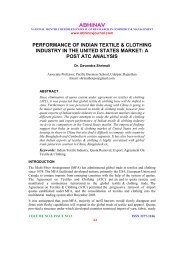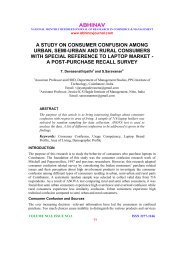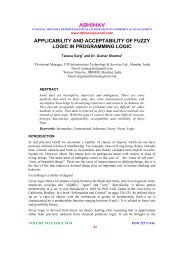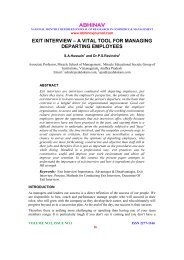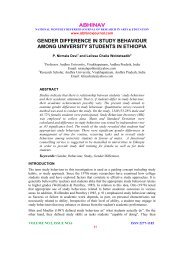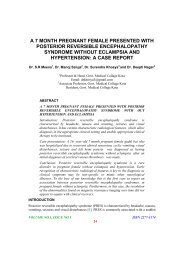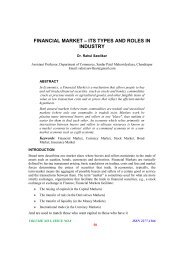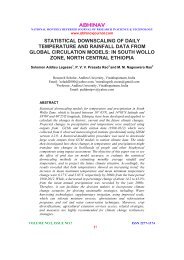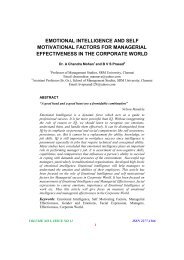Cryptography In Structure Adaptable Digital
Cryptography In Structure Adaptable Digital
Cryptography In Structure Adaptable Digital
Create successful ePaper yourself
Turn your PDF publications into a flip-book with our unique Google optimized e-Paper software.
ABHINAV<br />
NATIONAL MONTHLY REFEREED JOURNAL OF REASEARCH IN SCIENCE & TECHNOLOGY<br />
www.abhinavjournal.com<br />
CRYPTOGRAPHY IN STRUCTURE ADAPTABLE<br />
DIGITAL NURAL NETWORKS<br />
Pratap Singh 1 and Dr. Harvir Singh 2<br />
1 Lecture, IMS College, Roorkee<br />
pspartapsingh@gmail.com<br />
2 Director & Principal, Hindu college of Engineering, Hariyana<br />
ABSTRACT<br />
Neural networks can be used to generate common secret key. The goal of any<br />
cryptographic system is the exchange of information among the intended<br />
users without any leakage of information to others who may have<br />
unauthorized access to it. A common secret key could be created over a<br />
public channel accessible to any opponent. <strong>In</strong> case of structure adaptable<br />
digital neural cryptography, both the communicating networks receive an<br />
identical input vector, generate an output bit and are trained based on the<br />
output bit. The two networks and their weight vectors exhibit a novel<br />
phenomenon, where the networks synchronize to a state with identical timedependent<br />
weights. The generated secret key over a public channel is used for<br />
encrypting and decrypting the information being sent on the channel.<br />
Keywords: <strong>Structure</strong> <strong>Adaptable</strong> <strong>Digital</strong> Neural <strong>Cryptography</strong>, Mutual<br />
Learning, Cryptographic System, Key Generation.<br />
INTRODUCTION<br />
The basic need to provide security is using cryptography. Nowadays information security has<br />
become an important aspect in every organization. <strong>In</strong> other words, the people have to be<br />
assured that the information to be read by only the sender and receiver. <strong>In</strong> our work we are<br />
combining structure adaptable digital neural network and cryptography.<br />
<strong>Cryptography</strong><br />
<strong>Cryptography</strong> can also be defined as the conversion of data into a scrambled code that can be<br />
deciphered and sent across a public or private network. <strong>Cryptography</strong> is the practice and study<br />
of hiding information. It is an essential aspect for secure communication. <strong>Cryptography</strong> [1]<br />
not only protects data from theft or alternation but also can be used for user authentication.<br />
<strong>Cryptography</strong> uses two main styles or forms of encrypting data; symmetrical and<br />
asymmetrical. Symmetric encryptions, or algorithms, use the same key for encryption as they<br />
do for decryption. Other names for this type of encryption are secret-key, shared-key, and<br />
private-key. Asymmetric cryptography uses different encryption keys for encryption and<br />
decryption. <strong>In</strong> this case an end user on a network, public or private, has a pair of keys; one for<br />
encryption and one for decryption. These keys are labeled or known as a public and a private<br />
key.<br />
VOLUME NO.1, ISSUE NO.12 ISSN 2277-1174<br />
35
ABHINAV<br />
NATIONAL MONTHLY REFEREED JOURNAL OF REASEARCH IN SCIENCE & TECHNOLOGY<br />
www.abhinavjournal.com<br />
Within the context of any application-to-application communication, there are some specific<br />
security requirements, including:<br />
<strong>In</strong>tegrity: Assuring the receiver that the received message has not been altered in any<br />
way from the original.<br />
Non-repudiation: A mechanism to prove that the sender really sent this message.<br />
Authentication: The process of proving one's identity.<br />
Privacy/confidentiality: Ensuring that no one can read the message except the<br />
intended receiver.<br />
<strong>Cryptography</strong> Definitions<br />
Plaintext is either in a form that can be understood by a person (a document) or by a computer<br />
(executable code). Once it is not transformed into cipher text, human nor can machine<br />
properly process it until it is decrypted. This enables the transmission of confidential<br />
information over insecure channels without unauthorized disclosure. When this same sensitive<br />
information is sent over a network, it can no longer take these controls for granted, and the<br />
information is in a much more vulnerable state.<br />
A system that provides encryption and decryption is referred to as a cryptosystem and can be<br />
created through hardware components or program code in an application. The cryptosystem<br />
uses an encryption algorithm, which determines how simple or complex the process will be.<br />
Most algorithms are complex mathematical formulas that are applied in a specific sequence to<br />
the plaintext. Most encryption methods use a secret value called a key (usually a long string of<br />
bits), which works with the algorithm to encrypt and decrypt the text, as shown in figure 1.<br />
Figure 1: Use of a key<br />
If an eavesdropper captures a message as it passes between two people, she can view the<br />
message, but it appears in its encrypted form and is therefore unusable. Even if this attacker<br />
knows the algorithm that the two people are using to encrypt and decrypt their information,<br />
without the key, this information remains useless to the eavesdropper. So we can say that key<br />
is very important.<br />
<strong>Structure</strong> <strong>Adaptable</strong> <strong>Digital</strong> Nural Network<br />
<strong>Structure</strong> adaptable digital neural networks are parallel adaptive networks consisting of simple<br />
nonlinear computing elements called neurons which are intended to abstract and model some<br />
VOLUME NO.1, ISSUE NO.12 ISSN 2277-1174<br />
36
ABHINAV<br />
NATIONAL MONTHLY REFEREED JOURNAL OF REASEARCH IN SCIENCE & TECHNOLOGY<br />
www.abhinavjournal.com<br />
of the functionality of the human nervous system in an attempt to partially capture some of its<br />
computational strengths. Neural networks [2] [3] are non-linear statistical data modeling tools.<br />
They can be used to model complex relationships between inputs and outputs or to find<br />
patterns in data. A phenomenon of neural network is applied in cryptography systems. This is<br />
used for generating secret key over public channel.<br />
<strong>Structure</strong> adaptable digital neural networks with their remarkable ability to derive meaning<br />
from complicated or imprecise data can be used to extract patterns and detect trends that are<br />
too complex to be noticed by either humans or other computer techniques [4] [5]. A trained<br />
neural network can be thought of as an "expert" in the category of information it has been<br />
given to analyze. Other advantages include:<br />
1. Adaptive learning: An ability to learn how to do tasks based on the data given for<br />
training or initial experience.<br />
2. Self-Organization: An ANN can create its own organization or representation of the<br />
information it receives during learning time.<br />
3. Real Time Operation: ANN computations may be carried out in parallel, and special<br />
hardware devices are being designed and manufactured which take advantage of this<br />
capability.<br />
4. Fault Tolerance via Redundant <strong>In</strong>formation Coding: Partial destruction of a network<br />
leads to the corresponding degradation of performance. However, some network<br />
capabilities may be retained even with major network damage.<br />
Background<br />
<strong>In</strong> cryptography pseudorandom number generators (PRNG’s) were used to generate secret<br />
keys between two communicating parties. These typically start with a “seed” quantity and use<br />
numeric or logical operations to produce a sequence of values. A typical pseudo-random<br />
number generation technique is known as a linear congruence pseudo-random number<br />
generator. These are the mechanisms used by real-world secure systems to generate<br />
cryptographic keys, initialization vectors, \random" nonce’s and other values assumed to be<br />
random. But here there are some possible attacks against PRNG’s [6]. Here an attacker may<br />
cause a given PRNG to fail to appear random, or ways he can use knowledge of some PRNG<br />
outputs (such as initialization vectors) to guess other PRNG outputs (such as secret key).<br />
Hence to overcome this disadvantage neural network is used in cryptography to generate the<br />
secret key. Here the generated secret key is random [7] [8].<br />
Neural <strong>Cryptography</strong><br />
<strong>In</strong>teracting Neural Network and <strong>Cryptography</strong><br />
Two identical dynamical systems, starting from different initial conditions, can be<br />
synchronized by a common external-signal which is coupled to the two systems. Two<br />
networks which are trained on their mutual output can synchronize to a time ependent state of<br />
identical synaptic weights [9]. This phenomenon is also applied to cryptography [10].<br />
<strong>Structure</strong> adaptable digital neural networks learn from examples. This concept has extensively<br />
been investigated using models and methods of statistical mechanics [11] - [12]. A “teacher”<br />
network is presenting input/output pairs of high dimensional data, and a student” network is<br />
VOLUME NO.1, ISSUE NO.12 ISSN 2277-1174<br />
37
ABHINAV<br />
NATIONAL MONTHLY REFEREED JOURNAL OF REASEARCH IN SCIENCE & TECHNOLOGY<br />
www.abhinavjournal.com<br />
being trained on these data. Training means, that synaptic weights adopt by simple rules to the<br />
input/output pairs [13]. After the training phase the student is able to generalize: It can<br />
classify – with some probability – an input pattern which did not belong to the training set. <strong>In</strong><br />
this case, the two partners A and B do not have to share a common secret but use their<br />
identical weights as a secret key needed for encryption. <strong>In</strong> structure adaptable digital neural<br />
network an attacker E who knows all the details of the algorithm and records any<br />
communication transmitted through this channel finds it difficult to synchronize with<br />
the parties, and hence to calculate the common secret key. We assume that the attacker E<br />
knows the algorithm, the sequence of input vectors and the sequence of output bits. <strong>In</strong>itial<br />
weight vectors and calculate the ones which are consistent with the input/output sequence. It<br />
has been shown, that all of these initial states move towards the same final weight vector, the<br />
key is unique [14]. However, this task is computationally infeasible. <strong>In</strong> principle, E could start<br />
from all of the Synchronization by mutual learning (A and B) is much faster than learning by<br />
listening (E). structure adaptable digital neural cryptography is much simpler than the<br />
commonly used algorithms [15] [16].<br />
Algorithm<br />
Figure 2: Tree Parity Machine<br />
Here is a simple neural network as shown in figure 2. It consists of an input vector x, a hidden<br />
layer sigma, a weights coefficients w between input vector and the hidden layer which is an<br />
activation procedure that counts the result value t. Such a neural network is called as neural<br />
machine. It is described by three parameters: K-the number of hidden neurons, N-the number<br />
of input neurons connected to each hidden neuron, and L-the maximum value for weight {-<br />
L...+L}. Two partners have the same neural machines. Output value is calculated by<br />
We update the weights only if the output values of neural machines are equal. There are three<br />
different rules like Hebbian learning rule [17] [18], Anti-Hebbian learning rule and Randomwalk<br />
learning rule<br />
VOLUME NO.1, ISSUE NO.12 ISSN 2277-1174<br />
38
ABHINAV<br />
NATIONAL MONTHLY REFEREED JOURNAL OF REASEARCH IN SCIENCE & TECHNOLOGY<br />
www.abhinavjournal.com<br />
Secret Key Generation<br />
Key Generation<br />
The different stages in the secret key generation procedure which is based on neural networks<br />
can be stated as follow [19]: as shown in figure 3.<br />
1. Determination of neural network parameters: k, the number of hidden layer units n,<br />
the input layer units for each hidden layer unit l, the range of synaptic weight values is<br />
done by the two machines A and B.<br />
2. The network weights to be initialized randomly.<br />
3. The following steps are repeated until synchronization occurs.<br />
4. <strong>In</strong>puts are generated by a third party (say the key distribution centre).<br />
5. The inputs of the hidden units are calculated.<br />
6. The output bit is generated and exchanged between the two machines A and B.<br />
7. If the output vectors of both the machines agree with each other then the<br />
corresponding weights are modified using the Hebbian learning rule, Anti-Hebbian<br />
learning rule and Random-walk learning rule [20].<br />
8. When synchronization is finally occurred, the synaptic weights are same for both the<br />
networks. And these weights are used as secret key.<br />
VOLUME NO.1, ISSUE NO.12 ISSN 2277-1174<br />
39
ABHINAV<br />
NATIONAL MONTHLY REFEREED JOURNAL OF REASEARCH IN SCIENCE & TECHNOLOGY<br />
www.abhinavjournal.com<br />
Implementation<br />
Figure 3: Key Generation<br />
<strong>In</strong> this section we will describe how to program neural machines and will show how to use<br />
MATLAB. The following figure 4 shows how to synchronize the two machines.<br />
The main function used here is tTPM (TPMTree Parity Machine [21]). It contains vectors: H<br />
and W. ‘H’ is used for internal operations during result value counting. ‘W’ contains weights.<br />
There are also four integer values: K, L, N, and TPOutput. Here in every iteration, we should<br />
produce the input vector, the count output value by using functions t<strong>In</strong>putVector() and<br />
CountResult(). Whenever the output of the two machines is same then the weights are updated<br />
using UpdateWeight() function. The FormRandomVector() function is used to find the<br />
random input vectors by the key distribution centre. To find the random bit the randi function<br />
from MATLAB is used which uniformly distributes pseudorandom integers.<br />
RESULT<br />
Table 1. Result table for Neutral Network Key Generator<br />
Sr.No. Different issues With NN Without NN<br />
1 Synchronization time Required Not required<br />
2 Randomness More No<br />
3 Security More Less<br />
Table 1 shows analysis made for neural network key generator.<br />
VOLUME NO.1, ISSUE NO.12 ISSN 2277-1174<br />
40
ABHINAV<br />
NATIONAL MONTHLY REFEREED JOURNAL OF REASEARCH IN SCIENCE & TECHNOLOGY<br />
www.abhinavjournal.com<br />
Synchronization Time<br />
The data set obtained for synchronization time by varying number of input units (n) is shown<br />
in figure 4. The number of iterations required for synchronization by varying number of input<br />
units (n) is shown in figure 5. The two figures show that as the value of n increases, the<br />
synchronization time and number of iterations also increases. The %iterations (actual/max)<br />
required for synchronization by varying number of input units (n) is shown in figure 6. The<br />
%synchronization time per iteration required for synchronization by varying number of input<br />
units (n) is shown in figure 7. <strong>In</strong> these two figures it is shown that as the value of n increases,<br />
the %iterations (actual/max) and %synchronization time per iteration is decreased.<br />
VOLUME NO.1, ISSUE NO.12 ISSN 2277-1174<br />
41
ABHINAV<br />
NATIONAL MONTHLY REFEREED JOURNAL OF REASEARCH IN SCIENCE & TECHNOLOGY<br />
www.abhinavjournal.com<br />
Randomness<br />
A random process is one whose consequences are unknown. <strong>In</strong>tuitively, this is why<br />
randomness is crucial in our work because it provides a way to create information that an<br />
adversary can’t learn or predict. When speaking about randomness, we commonly mean a<br />
sequence of independent random numbers, where each number was obtained completely<br />
random and has absolutely no correlation between any other numbers inside the sequence.<br />
Here in our work in each iteration we are going to get the different keys, hence randomness is<br />
more as shown in figure 8. So here an attacker cannot predict the key.<br />
VOLUME NO.1, ISSUE NO.12 ISSN 2277-1174<br />
42
ABHINAV<br />
NATIONAL MONTHLY REFEREED JOURNAL OF REASEARCH IN SCIENCE & TECHNOLOGY<br />
www.abhinavjournal.com<br />
Figure 8: Randomness Vs No. of Trials<br />
Here we can say that security is directly proportional to randomness, hence we have achieved<br />
security as well.<br />
CONCLUSION<br />
<strong>In</strong>teracting structure adaptable digital neural networks have been calculated analytically. At<br />
each training step two networks receive a common random input vector and learn their mutual<br />
output bits. A new phenomenon has been observed: Synchronization by mutual learning. The<br />
two partners can agree on a common secret key over a public channel. An opponent who is<br />
recording the public exchange of training examples cannot obtain full information about the<br />
secrete key used for encryption .This works if the two partners use multilayer networks, parity<br />
machines. We have shown graphs by which we can come to know that synchronization time<br />
will go on decreasing as the number of inputs increase. The opponent has all the information<br />
(except the initial weight vectors) of the two partners and uses the same algorithms.<br />
Nevertheless he does not synchronize. Here we have also achieved the randomness of key.<br />
FUTURE WORK<br />
The key distribution centre generated the secret key. Our future work is that the key<br />
distribution centre will distribute the generated key securely by some method.<br />
REFERENCES<br />
1. William Stallings, <strong>Cryptography</strong> and Network Security.<br />
2. Jacek M. Zurada, <strong>In</strong>troduction to Artificial Neural Systems.<br />
3. John A. Bullinaria: <strong>In</strong>troduction to Neural Networks, 2004.<br />
4. Eric S Imsand, Deon Garrett, John A. Hamilton, Jr., Member, IEEE: User Identification<br />
Using GUI Manipulation Patterns and Artificial Neural Networks.<br />
5. Henry A. Rowley, Shumeet Baluja, and Takeo Kanade: Neural Network-Based Face<br />
Detection, January 1998.<br />
VOLUME NO.1, ISSUE NO.12 ISSN 2277-1174<br />
43
ABHINAV<br />
NATIONAL MONTHLY REFEREED JOURNAL OF REASEARCH IN SCIENCE & TECHNOLOGY<br />
www.abhinavjournal.com<br />
6. John Kelsey, Bruce Schneier, David Wagner, Chris Hall: Cryptanalytic Attacks on<br />
Pseudorandom Number Generators.<br />
7. Peter Gutmann, David Naccache, Charles C. Palmer: Randomness in <strong>Cryptography</strong>, 2006.<br />
8. Jorg Muhlbacher, DI Rudolf Hormanseder: Randomness in <strong>Cryptography</strong>, October 2007.<br />
[9] R. Metzler and W. Kinzel and 1. Kanter, Phys. Rev. E, 62, 2555 (2000).<br />
9. Kaniter, W. Kinzel and E. Kanter, Europhys. Lett, 57,141-147 (2002).<br />
10. M. Rosen-Zvi, E. Klein, 1. Kanter and W. Kinzel, "Mutual leamning in a treepanty<br />
machine and its application to cryptography", Phys. Rev. E (2002).<br />
11. Neural Synchronization and <strong>Cryptography</strong> – Andreas Ruttor. PhD thesis, Bayerische<br />
Julius- Maximilians-Universitat Wurzburg, 2006.<br />
12. Steve Lawrence, C. Lee Giles, Ah Chung Tsoi: Lessons in Neural Network Training:<br />
Overfitting May be Harder than Expected, 1997.<br />
13. R. Urbanczik, private communication<br />
14. C.P. Williams and S.H. Cleat-water, Explorations in Quantum Computing, Springer<br />
Verlag, 1998. [16] D. R. Stinson, <strong>Cryptography</strong>: Theory and Practice (CRC Press 2002).<br />
15. Gal Chechik, Isaac Meilijson, Eytan Ruppin: E_ective Neuronal Learning with <strong>In</strong>e_ective<br />
Hebbian Learning Rules, October 26, 2000.<br />
16. Daniel A. Butts, Patrick O. Kanold, Carla J. Shatz: A Burst-Based ‘‘Hebbian’’ Learning<br />
Rule at Retinogeniculate Synapses Links Retinal Waves to Activity-Dependent<br />
Refinement, March 2007.<br />
17. J. Hertz, A. Krogh, and R. G. Palmer: <strong>In</strong>troduction to the Theory of Neural Computation,<br />
(Addison Wesley, Redwood City, 1991).<br />
18. Einat Klein, Rachel Mislovaty, Ido Kanter, Andreas Ruttor, Wolfgang Kinzel:<br />
Synchronization f neural networks by mutual learning and its application to cryptography.<br />
19. Engel and C. Van den Broeck: Statistical Mechanics of Learning, (Cambridge University<br />
Press, 2001).<br />
VOLUME NO.1, ISSUE NO.12 ISSN 2277-1174<br />
44





